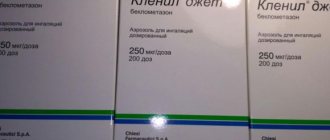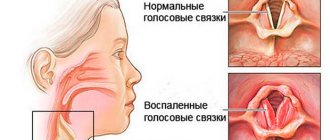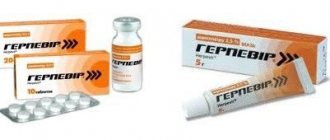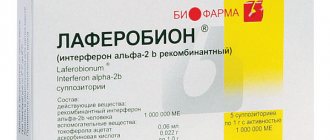Pulmicort for inhalation is used in the treatment of the respiratory tract in adults and children. The daily dosage of the drug is on average 0.5 mg, but for children it is possible to reduce it by half, and in especially severe cases the dosage is doubled, regardless of the patient’s age.
Available in the form of a suspension or powder, it has a complex effect (anti-inflammatory, antiallergic, strengthens the immune system), and almost instantly relieves an attack of suffocation or dry cough. The cost of Pulmicort ranges from 900-2000 rubles for 20 single doses, it is stored for 2 years and only in a cool, dark place.
It is used after dilution with saline, unless otherwise specified in the doctor's prescription. Available in pharmacies with a prescription. The drug is hormonal, so the duration of therapy is determined by a specialist; it is often used to solve emergency problems - acute suffocation, bronchospasm. Contraindicated in children under 6 months of age, undesirable during pregnancy and breastfeeding, with liver and kidney diseases.
Main characteristics of the drug for inhalation Pulmicort
Pulmicort is an inhalation drug that is used against cough even in the most advanced cases. The drug belongs to the category of hormonal, therefore it is prescribed by doctors taking into account the patient’s condition. Brief characteristics of the drug:
| International name Pulmicort | Budesonide |
| Release form | Suspensions in bags or powder for the preparation of inhalation solution. |
| Composition of the drug | The main active ingredient is budesonide (glucocorticosteroid), auxiliary ingredients are sodium chloride, polysorbate 80, purified water, sodium citrate, citric acid, sodium salt. |
| Action | Anti-inflammatory, immunosuppressive, antiallergic. |
| Storage conditions | The sealed package can be stored for 2 years at temperatures below 30 degrees Celsius (in the refrigerator on the door). Opened packaging is used within 3 months. Packages and containers with the drug should not be exposed to light. |
What is Pulmicort, its effect on the body
Pulmicort is a prescription drug from the category of glucocorticosteroids intended for the treatment of respiratory tract diseases using inhalation. There are only two forms of release:
- suspensions - may contain 0.25 or 0.5 mg/ml of the main active ingredient, produced in a cardboard package containing 20 packets with an already dosed drug (for 1 inhalation);
- powder - produced in doses, may contain 100 or 200 mg of the active substance.
The drug has a complex effect on the respiratory system - anti-allergic, anti-inflammatory, strengthens local and general immunity. Actively used in pediatric practice.
Composition of the drug and main active ingredient
The main active ingredient is budesonide - a glucocorticosteroid; the composition of the drug in the form of a suspension is additionally enriched with sodium citrate, citric acid, purified water, sodium salt, sodium chloride and polysorbate 80. All these components do not have a therapeutic effect, do not cause allergies and have virtually no side effects effects.
Budesonide has a local anti-inflammatory effect, reduces the frequency of exacerbations/attacks of bronchial asthma. At the same time, the side effects inherent in glucocorticosteroid drugs in this case appear with less intensity or are completely absent. Pulmicort is well tolerated even with long-term use, reduces swelling of the mucous membranes, and activates the process of removing accumulated mucus from the respiratory tract.
Indications for use
General indications for the use of Pulmicort are:
- asthma of all types, types and at any stage of development;
- rhinitis (runny nose), occurring in a severe chronic form;
- previously diagnosed and actively growing polyps in the respiratory tract;
- hay fever of various origins;
- pulmonary obstruction;
- psoriasis in severe form;
- dermatitis, regardless of etiology;
- nasopharyngitis;
- pathological lesions of the bronchi of the infectious type.
It is strictly forbidden to self-prescribe inhalations with Pulmicort, even if you have a history of the listed pathologies.
Contraindications
In pediatric practice, the drug is not prescribed to children under 6 months of age; all other contraindications are general:
- cirrhosis of the liver, even if treatment has been completed and long-term drug remission has occurred;
- pulmonary infections in the acute period;
- chronic pathologies of the kidneys and urinary system;
- tuberculosis of various types - skin, lungs;
- benign and malignant tumors localized in the face and head.
Before prescribing Pulmicort, the doctor is obliged to find out the body's expected reaction to the main active ingredient budesonide - the development of a powerful, rapid allergy, up to anaphylactic shock, Quincke's edema is possible.
Price, where to buy
The price of Pulmicort for inhalation varies depending on the calculated doses. 20 pieces of 500 mcg/ml can be purchased from 1150 to 1250 rubles. Nebulas for 20 pieces of 250 mcg/ml cost from 800 to 950 rubles.
The price for Pulmicort Turbuhaler in different pharmacies is set from 700 to 800 rubles. for the 100 mcg per dose option. The option with 200 mcg per dose costs about 450 rubles.
- Online pharmacies in RussiaRussia
- Online pharmacies in UkraineUkraine
- Online pharmacies in KazakhstanKazakhstan
ZdravCity
- Pulmicort Turbuhaler powder for injection.
dosage 100 µg/dose 200 doses AstraZeneca AB RUB 751 order - Pulmicort Susp. for in. 0.5 mg/ml cont. 2ml 20 pcs AstraZeneca AB
RUB 1,176 order
- Pulmicort Susp. for in. 0.25 mg/ml cont. 2ml 20 pcs AstraZeneca AB
RUR 838 order
- Pulmicort Turbuhaler powder for injection. dosage 200µg/dose 100 doses AstraZeneca AB
RUR 431 order
Pharmacy Dialogue
- Pulmicort sachets 0.25 mg/ml 2 ml No. 20Astra Zenesa
913 RUR order
- Pulmicort Turbuhaler (portion d/ing. 100 mcg/dose 200 doses) Astra Zenesa
RUR 779 order
- Pulmicort sachets 0.5 mg/ml 2 ml No. 20Astra Zenesa
RUR 1,198 order
- Pulmicort Turbuhaler (portion d/ing. 200 mcg/dose 100 doses) Astra Zenesa
418 RUR order
show more
Pharmacy24
- Pulmicort Turbuhaler powder for inhalation 200 mcg/dose 100 doses Astra Zeneca AB, Sweden
276 UAH.order - Pulmicort Turbuhaler powder for inhalation 100 mcg/dose 200 doses Astra Zeneca AB, Sweden
269 UAH. order
- Pulmicort nebula 0.5 mg/ml 2 ml N20 suspension for inhaler Astra Zeneca AB, Sweden
759 UAH. order
- Pulmicort nebula 0.25 mg/ml 2 ml No. 20 suspension for inhaler Astra Zeneca AB, Sweden
526 UAH order
PaniPharmacy
- aerosol Pulmicort turbuhaler 100 mg/dose 200 doses Ukraine, AstraZeneca
277 UAH order
- Pulmicort liquid Pulmicort suspension. d/spray 0.25 mg/ml cont. 2ml No. 20 (4x5) Sweden, AstraZeneca
548 UAH order
- Pulmicort liquid Pulmicort suspension for spraying 0.5 mg/ml container 2 ml No. 20 (4x5) Sweden, AstraZeneca
812 UAH order
- aerosol Pulmicort turbuhaler 200 mg/dose 100 doses Ukraine, AstraZeneca
273 UAH order
show more
Instructions for use Pulmicort for inhalation in children
The use of Pulmicort for inhalation in childhood is regulated by the instructions for the drug, which give the following recommendations:
| Indications | Optimal dose and duration of therapy |
| When coughing |
|
| For pneumonia |
|
| For sinusitis |
|
Pulmicort can be diluted with 0.9% saline solution in a 1:1 ratio.
Indications
Despite the fact that the drug is a glucocorticosteroid, which is extremely undesirable to use in the treatment of children, there are a number of indications for which Pulmicort is necessary:
- laryngitis;
- bronchitis;
- dry cough with a characteristic whistling sound;
- laryngotracheitis.
Only acute pathological conditions in the listed diseases are the basis for inhalation with Pulmicort. This is an emergency measure if it is necessary to quickly alleviate the child’s condition.
What dosage is needed: 0.25, 0.5 mg
The dosage of the drug can be 0.25 mg - this is the optimal choice, this dose is effective and safe, 0.5 mg is the maximum permissible dosage in pediatrics. It is extremely rare for doctors to prescribe inhalations in a daily dosage of 1 mg - the procedure is carried out twice a day and is advisable for frequently recurring attacks of suffocation or a general serious condition against the background of progression of the underlying disease.
When choosing a dosage, the doctor also takes into account the patient’s age - for children from 6 months to 2 years, the maximum daily dose is 0.25 mg, at a later age it can be increased according to the above recommendations.
How to dilute Pulmicort with saline solution
Pulmicort is diluted with saline solution as follows:
- take 1 ml of the drug in question;
- combine with 1 ml of 0.9% saline solution;
- mix thoroughly.
You can dilute the drug yourself with saline solution, but if the doctor recommends using Terbutaline, Fenoterol or Salbutamol for these purposes, then you need to purchase a ready-made aerosol at the pharmacy.
If Pulmicort is used for a nebulizer, then it should be diluted with saline in the following proportions:
- 25 mg of drug suspension – 1 ml;
- 0.5 mg – 2 ml saline solution;
- 0.75 mg – 3 ml.
Watch this video on how to dose Pulmicort correctly:
Mode of application
Only a doctor prescribing Pulmicort can choose a competent, safe and effective method of use; it depends on several factors:
- patient's age;
- general condition – severe, moderate, or there was a timely visit to the doctor at the beginning of the progression of the disease;
- the nature of the cough - wet, dry, paroxysmal, and so on;
- the need to carry out procedures in the evening.
When coughing
When coughing, Pulmicort is used 1-2 times a day in the dosage prescribed by the doctor - often 0.5 mg per procedure. For acute cough, or if it occurs against the background of an attack of laryngitis with characteristic suffocation, the duration of therapy is 3 days. If there is no positive dynamics, cancel the procedure after 1-2 applications.
In special cases, when the cough is prolonged or advanced, treatment with Pulmicort can last 7-10 days.
For pneumonia
The maximum daily dose of the drug for pneumonia in a child is 0.5 mg, more often 0.25 mg is prescribed. Before 6 months of age, Pulmicort is contraindicated for use, even in severe cases. The duration of therapy is prescribed on an individual basis, but if there are no asthma attacks, then after 2-3 days the manipulations are canceled.
The maximum duration of use of Pulmicort in the treatment of pneumonia in children is 5 days.
For sinusitis
For sinusitis, the daily dosage for children is 1 mg, divided into 2-3 procedures per day. Inhalations are carried out at regular intervals. Sinusitis requires long-term treatment; complex therapy may include inhalations of the drug in question, which are prescribed for a period of 5-7 days.
Reducing the time of use of Pulmicort will not give a long-term effect; a one-time procedure will only relieve swelling of the mucous membranes for a few hours and make it easier for the child to breathe.
How to breathe Pulmicort through a nebulizer
You can breathe Pulmicort through a nebulizer with a mask or mouthpiece; the drug is not used in ultrasound equipment. First, the required dose of the drug is poured into the desired compartment of the device and saline solution is added. The mask should fit tightly to the child’s face - this method of inhalation is used at a younger age; for older children, you can use a mouthpiece.
The drug penetrates the respiratory tract only with inhalation - calm and, if possible, deep. Therefore, the child must behave calmly during the procedure, not scream or cry, or talk.
How long can a child breathe Pulmicort?
A child can breathe Pulmicort for no more than 10 minutes. During this time, a single dose of the drug will be consumed, the active substance will penetrate into all parts of the respiratory tract.
If the procedure is carried out to relieve acute bronchospasm, then the child should breathe for 3-5 minutes, but repeat every 30-50 minutes. More precise instructions can be obtained from the doctor who is monitoring the patient and will monitor the dynamics of his condition.
How often can the procedures be done?
A child should not breathe Pulmicort too often - an overdose of the main active ingredient and severe side effects may occur. A sick child is prescribed 1-2 procedures per day, which are carried out every 12 hours.
The exception is acute conditions, when a child is suffocating and is diagnosed with laryngeal edema, which threatens his life. In this case, you can quickly alleviate the condition and prevent repeated attacks with “shock” doses of Pulmicort. Inhalations are prescribed every 20-40 minutes, but only for 1 day - it is necessary to monitor the dynamics of the development of the condition, after which they can be transferred to maintenance therapy with a one-time manipulation per day.
How long does it take for the effect to occur?
The effect of inhalation occurs literally immediately - after the first use, the child’s breathing becomes easier and more free. The pronounced result of the procedure is noted after 3 hours, and it is possible to consolidate it and achieve complete restoration of breathing only after 3-10 days of therapy.
Improvement of bronchophonography in children from 1 year to 5 years after inhalation of Pulmicort solution
Is it possible at a temperature
Pulmicort for inhalation can be performed at body temperature up to 37 degrees; if this figure is exceeded, the procedure is prohibited until the patient recovers. Any thermal or warming manipulations are contraindicated at elevated body temperatures, because such a combination can provoke:
- further increase in indicators, up to critical ones;
- exacerbation of any inflammatory processes;
- deterioration of general condition - the child may begin to vomit.
When is it better - before or after meals?
Inhalations are carried out 30-60 minutes before or after meals, because the procedure often provokes attacks of nausea and vomiting in childhood - with a full stomach they can develop into an active effect.
If the drug gets into the respiratory tract, it is undesirable to wash off the film from the larynx, so even drinking within an hour after inhalation is not allowed.
Harm to the child
The harm of Pulmicort for a child is the high probability of stunting its growth - this can happen with long-term therapy with the drug. This is due to suppression of adrenal function, when the production of somatotropin, the hormone responsible for growth, stops.
Watch this video about the indications, mechanism of action and side effects of Pulmicort:
Contraindications
Pulmicort should not be used in the following cases:
- In young children (Pulmicort can be used only in children older than six months and only for acute indications);
- If there is a negative immune response to any component of the product;
- In the presence of tuberculous lung disease, especially during an exacerbation;
- When the skin is affected by syphilis;
- If there is an infectious or fungal infection of the respiratory system;
- In case of severe liver failure;
- In the presence of tuberculous or malignant skin lesions.
If there is any contraindication, you must inform your doctor about it to select another type of therapy.
Instructions for adults for the use of Pulmicort for inhalation
Instructions for adults for the use of Pulmicort for inhalation indicate the following nuances:
- the dosage can be much higher than that used in pediatric practice, and can range from 1 to 4 mg;
- the frequency of procedures can be increased;
- the drug can be used for a long time, up to 1 month of daily inhalations (in especially advanced cases).
Pulmicort can be used both as an emergency option for an acute attack of asthma, and as the main therapy for chronic respiratory diseases.
Dosage
Treatment begins with a daily dosage of 1 mg; after 5 days of therapy, the doctor evaluates the dynamics of the disease and, if necessary, increases the dose to 2-4 mg per day. In case of severe condition, frequently recurring attacks of suffocation for 1-3 days, an adult is given inhalations with 4 mg of Pulmicort (dose divided by 2 times). Deterioration of the patient’s well-being is a reason to perform the procedure with a “pure” suspension, without first diluting it with saline solution.
Pulmicort for dry cough in adults: will it help?
Pulmicort is an excellent remedy for dry coughs in adults - it provokes active secretion of mucus from the mucous membranes of the respiratory tract, and repeated procedures make it possible to completely remove it.
The drug is indicated for laryngotracheitis, laryngospasm and prolonged dry cough of any origin. In general, inhalation procedures are an effective therapy specifically for dry coughs, when the formation of sputum and its discharge are too slow or completely absent.
Nebulizer recipe
For the nebulizer, a suspension of the drug is used; first you need to prepare a solution for the equipment according to the classic recipe - take 1 ml of saline solution for 1 ml of the drug. This manipulation is best carried out in a nebula - a special compartment on the equipment into which medications for inhalation are poured.
At the end of the manipulation, you need to wash your face and rinse your mouth with warm water, in which you can dissolve baking soda (1 teaspoon per glass). The nebulizer itself must be washed and dried, and if therapy lasts more than 2 weeks, then you will need to sterilize the equipment - wipe it with medical alcohol, any antiseptic (Chlorhexidine, Miramistin), boil the mouthpiece.
Watch this video on how to use saline nebulizer:
How to breathe Pulmicort
The drug enters the respiratory tract only when inhaled, so it should be deep, calm and slow. As soon as you inhale as deeply as possible, you need to hold your breath for 1-3 seconds and exhale through your nose. The procedure continues until the nebula runs out of the drug - usually 5-10 minutes.
At first, the device works slowly, and the spraying does not proceed fully, then the process accelerates, so breathing must be even - you cannot talk, or take sharp and shallow breaths.
You can breathe every 20-30 minutes if there is an exacerbation of bronchial asthma, attacks of suffocation begin and are constantly repeated. As soon as the patient’s condition improves, inhalations are carried out on the usual schedule - every 12-24 hours.
How many days to do inhalations
If the patient’s condition does not threaten his life, Pulmicort is used in complex therapy, then inhalations need to be done for 3-5 days. All this time you need to monitor the dynamics of the disease, and if there is no improvement, the doctor must adjust the treatment regimen and either increase the dosage of the drug or select more effective drugs.
In especially severe cases, the duration of inhalations increases to 3-4 weeks on a daily basis. But after 1-2 weeks, daily dosages are reduced - maintenance therapy begins - “consolidating the result.”
Inhalation with Pulmicort during pregnancy and breastfeeding
Inhalations with Pulmicort have been studied, but there is no reliable data on whether this glucocorticosteroid drug affects the intrauterine development of the fetus during pregnancy. Doctors can prescribe a procedure only if the pathological condition threatens the woman’s life, and the risk exceeds the likelihood of giving birth to a sick child.
Be sure to reduce the daily dosage to the possible minimum, the frequency of repetitions of inhalations does not exceed 1 time per day, the duration of therapy is a maximum of 7 days (if the woman’s condition is serious).
Breastfeeding is a clear contraindication for the use of Pulmicort in inhalation procedures - the main active substance passes into breast milk, but how it affects the growth, weight and development of the child is unknown.
Pulmicort and alcohol
Pulmicort and alcohol are categorically incompatible. The body’s reaction to this combination is identical to that which occurs when combining alcohol-containing drinks and antibacterial drugs:
- nausea, vomiting, weakness, dizziness;
- pain in the intestines, indigestion, even severe diarrhea;
- liver dysfunction.
Can it be used for problems with the liver and kidneys?
Renal failure, inflammatory processes in the liver, cirrhosis - these diseases are a conditional contraindication to the use of Pulmicort inhalations. The risk of increased progression of existing pathologies should be assessed by the doctor, after which he will make prescriptions or select another drug for therapy.
If liver and kidney diseases are in a state of long-term drug remission, then inhalations are possible. But the daily dosage should be reduced to the possible minimum, as well as the frequency of procedures.
During pregnancy and lactation
When pregnant women take the substance budesonide, no increased risk of developing abnormalities in the fetus has been found. However, these risks should not be completely excluded, therefore, when taking the drug during pregnancy , you should use the minimum effective dosage of the drug to avoid worsening bronchial asthma .
Animal studies have shown results of the development of fetal abnormalities when taking corticosteroids, but these data cannot be transferred to people who receive recommended doses of glucocorticosteroids.
The following information will be useful for nursing mothers: there is no evidence that budesonide can pass into breast milk. But still, when prescribing this drug, you need to take into account the potential risks for the child, comparing them with the expected benefits.
Side effects
Side effects of Pulmicort are always pronounced and present quite often, especially if long-term therapy with the drug is carried out, possible include:
- nausea and vomiting;
- excessive dry mouth;
- development of thrush on the oral mucosa;
- rashes on the skin - small, without content, resembling ordinary urticaria;
- sudden spasm of the bronchi;
- severe headaches.
In some cases, sudden changes in mood, depression, and excessive excitability are possible. Any of the listed side effects is a reason to immediately discontinue therapy.
If a mask is used during inhalation, irritation and even bruising may occur on the face (especially often diagnosed in young children). These are short-term phenomena that do not require a change in drug.
special instructions
To minimize the risk of oropharyngeal fungal infection, the patient should be instructed to rinse the mouth with water after each inhalation of this medication.
The drugs Pulmicort and Pulmicort Turbuhaler should not be taken together with Itraconazole , Ketoconazole , as well as other substances that retain CYP 3A4 in the body. If these substances were nevertheless prescribed to the patient simultaneously with budesonide (the main active ingredient of the drug), then the time between doses of these drugs should be maximized.
Due to the risks that pituitary-adrenal function may be weakened, special attention is required to those patients who are transferred to Pulmicort and Pulmicort Turbuhaler from oral glucocorticosteroids. In addition, special attention should be paid to those patients who have received the maximum recommended doses of glucocorticosteroids for a long time. Such patients may experience symptoms and signs of adrenal insufficiency . Also, in cases of surgery or stress, additional therapy with systemic glucocorticosteroids is recommended.
Particular attention should be paid to those patients who are transferred from systemic to inhaled glucocorticosteroids, as well as in cases where a violation of the pituitary-adrenal function is expected. In these cases, it is necessary to carefully reduce the dose of systemic glucocorticosteroids, as well as monitor adrenal hormonal function.
If a patient switches from taking oral corticosteroids to Pulmicort or Pulmicort Turbuhaler, he may experience symptoms such as joint pain or muscle pain. In this case, it may be necessary to temporarily increase the dose of oral corticosteroids. In some cases, nausea and vomiting, headache, and fatigue may also occur, which indicates a systemic deficiency of glucocorticosteroids.
If oral corticosteroids have been replaced by inhaled ones, then sometimes a concomitant allergy ( eczema or rhinitis ) appears, which was previously treated with systemic medications.
In addition, patients should be instructed that if the effectiveness of therapy with short-acting bronchodilators is reduced, they should consult a doctor, since an unauthorized increase in the frequency of use of the drug may delay the prescription of an adequate dosage for treatment. If there is a sudden deterioration in the condition, then the possibility of treatment with oral corticosteroids should be considered.
How to store it correctly
Storage rules for Pulmicort:
- if the package is closed, it can be stored for 2 years in a cool place;
- opened packages are stored for a maximum of 3 months and also in a cool place;
- if the container with the drug is opened (for example, to use only half the dose), then the rest should be used within 12 hours maximum.
It is important to prevent light, and especially direct sunlight, from coming into contact with the drug packaging.
Pharmacokinetics
Absorption of budesonide in the human body occurs in a short time. About 1/4 of the total medication taken penetrates into the lungs. In the blood, the highest concentration of the active substance is observed after half an hour. Metabolism occurs through interaction with CYP-3A4 enzymes; upon completion, the processed components are excreted from the body in the urine. If you have liver disease, this process may take a longer period of time. The initial effect is observed within a few hours, and the result of systematic procedures becomes noticeable after two weeks.
Analogues of Pulmicort for inhalation
Analogues of Pulmicort must contain the same main active ingredient for inhalation - budesonide.
| Name of the analogue Pulmicort | Main characteristics | Photo |
| Pulmicort Turbuhaler | Available only in powder form, it has a powerful targeted anti-inflammatory effect. Sold in a metered dose inhaler, one inhalation delivers the required dose of the drug into the respiratory tract. It is possible to develop side effects with long-term use - urticaria, hoarseness, bronchospasm. | |
| Tafen nasal | Available in a dark glass bottle with a nozzle for administering the drug into the nose. It is used for chronic rhinitis, nasopharyngitis, and can reduce the intensity of the inflammatory process in the lower respiratory tract. Side effects develop extremely rarely and are transient in nature. In pediatric practice it is used from the age of 6. | |
| Benacort | Available in the form of a powder or solution for inhalation, it additionally contains succinic acid, which increases the likelihood of developing an allergy to the drug. Contraindicated for use in pediatric practice (up to 16 years), for diseases of the thyroid gland, osteoporosis. | |
| Saltos | Available in the form of tablets, intended for long-term therapy, it perfectly relieves acute bronchospasm, prevents the development of attacks at night. Contraindicated in diagnosed heart failure, it often causes side effects such as trembling of the upper extremities (hand tremors) and tachycardia. Not used in pediatric practice. | |
| Budoster | Nasal spray, which is a whitish suspension. It is used for chronic rhinitis, including those of allergic origin, and can act as a prophylaxis against seasonal exacerbation. Not prescribed for treatment in children under 6 years of age. |
Replacing the drug in question with analogues on its own is strictly prohibited - they may be less effective and have powerful side effects. Almost all analogues are not used in pediatric practice.
Drug interactions
No interaction of budesonide with other drugs used to treat bronchial asthma was observed.
If simultaneous use of ketoconazole is necessary, the dose of budesonide should be reduced and the interval between doses should be increased as much as possible.
Plasma concentrations of budesonide are significantly increased by itraconazole, a potential inhibitor of CYP3A4.
The use of beta-agonists for preliminary inhalation helps to dilate the bronchi, improve the entry of budesonide into the respiratory tract, and enhance its therapeutic effect.
When combined with phenytoin, phenobarbital, rifampicin, the effect of Pulmicort is reduced, and in combination with estrogens, methandrostenolone, it increases.
What to pay attention to
When using the drug Pulmicort, you need to pay attention to the following aspects:
- To prevent fungal infection of the oral mucosa, it is recommended to rinse your mouth thoroughly with water or a solution after each inhalation of the drug.
- Washing your face won’t be a bad idea; it will serve as a preventive measure for various skin irritations.
- When using drugs in parallel, which actively accumulate in the liver, you should refrain from using Pulmicort or these drugs.
- If you have previously been prescribed other groups of drugs with glucocorticosteroids for a long time, you must be under medical supervision in the first days of using Pulmicort. This serves to prevent the development of significant side effects and negative effects on the organs and systems of the body.
- If it is necessary to use Pulmicort for children, their physical and mental development should be regularly assessed.
- During pregnancy and lactation, Pulmicort can be used only for absolute indications, otherwise this drug should be postponed until the end of these periods.
- When developing treatment tactics with the drug Pulmicort, it is necessary to inform the doctor about taking other groups of drugs so that the specialist can use it.
If you follow these simple requirements, then Pulmicort will not have a negative effect on your health.
Indications for use
Pulmicort instructions for use indicate that the drug can be used for therapeutic and prophylactic purposes for the following pathologies of the respiratory system:
- Bronchial asthma.
- Allergic form of rhinitis.
- Laryngitis with stenosis.
- Chronical bronchitis.
- Emphysema.
- False croup.
- Chronic pharyngitis.
Inhalation procedures using Pulmicort are often used for acute attacks of bronchial asthma or for prophylaxis to reduce the risk of attacks. Pulmicort for bronchitis reduces the intensity of cough and has an anti-inflammatory effect. In acute forms of laryngitis, the drug is also effective; Pulmicort is prescribed for dry cough and other diseases of the bronchopulmonary system. Its use allows you to relieve bronchial swelling, restore breathing, and reduce the risk of complications.
Overdose
If you take Pulmicort once in an exceeded dose, no consequences will arise. However, with long-term use of large doses of the drug, disturbances in the functioning of the adrenal glands occur. In addition, the following negative consequences appear:
- Instability of blood pressure, mainly in the direction of increasing indicators;
- Increasing muscle weakness;
- Increase in fat mass in the body;
- Reduced or complete absence of menstrual flow;
- The appearance of pigment spots on the skin.
Even if side effects do not appear, to prevent them, gradual withdrawal of Pulmicort is recommended, especially in the case of a long period of use.









